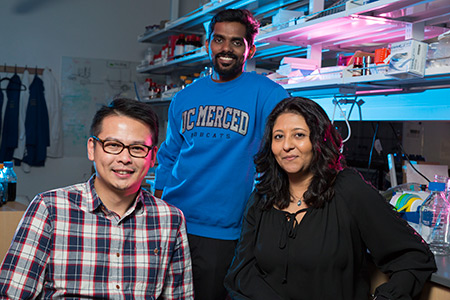 In recent publications, Professor Vincent Tung proves that inspiration for advancements in materials science can come from anywhere — even the merging of raindrops on a windshield or the sheeting of red wine down the inside of a glass.
In recent publications, Professor Vincent Tung proves that inspiration for advancements in materials science can come from anywhere — even the merging of raindrops on a windshield or the sheeting of red wine down the inside of a glass.
Through those liquid movements, Tung discovered and optimized a new, low-cost, scalable and environmentally friendly way of using perovskite, an extremely thin and highly efficient material that is at the forefront of photovoltaic research.
Teaming up with physics Professor Sayantani Ghosh, Tung published three papers last year that earned the covers of materials, physics and chemistry journals. Their interdisciplinary collaboration demonstrates work that could change the way solar cells are produced.
The first paper, in Advanced Materials Interfaces, deals with the rainy-day inspiration during the long commute between Lawrence Berkeley National Lab and UC Merced that prompted Tung to think of depositing perovskite on flat surfaces the way an ink-jet printer deposits ink on paper.
“I was stopped in traffic and watching the way raindrops landed and merged on my windshield, and thought we could place droplets containing perovskite on surfaces like that,” Tung said. “We engineer the dots to coalesce into one another and then merge into a uniform thin film within seconds. More importantly, you only need a fractional amount of the ‘ink,’ which is far more efficient than the traditional method of spin-coating.”
When surfaces are spin-coated, about 70 percent of the coating material flies off and is lost. It’s material that necessarily includes lead, so Tung’s method is not only more cost effective and less wasteful, it’s also better for the environment.
In the Journal of Materials Chemistry A, Tung and his research colleagues revealed that they could further improve the process by using a sheeting method Tung thought of while watching the legs of red wine sheet down the inside of his glass.
“In the first study, we could only deposit the material on certain materials, but with this method, we can deposit it on nearly any surface, even flexible ones, and it’s still highly efficient,” he said. “The second method uses the hydrodynamics of liquid. We combined two solvents to make the perovskite sheet, and the differences in vapor pressure push the solvents to merge.”
One of the challenges in making thin-film solar cells is that the films can become grainy, but scientists and engineers want them to be like a single crystal. Tung’s methods largely eliminate grain boundaries, producing a much smoother morphology in both surfaces and cross-sections.
Perovskite has made rapid increases in energy conversion efficiency, improving from less than 4 percent efficiency in 2010 to a record efficiency of 22 percent in 2016. Because it is highly absorbent, manufacturers will need to use far less perovskite than they would the traditional silicon to make solar cells. The applications can be scaled up, as well, which is another obstacle in previous methods that Tung’s developments help overcome.
Tung, a chemist and materials scientist, makes and characterizes the materials, and Ghosh, a physicist, studies the behavior of the materials. While Tung uses the scanning electron microscope to examine, in extremely high resolution, small sections of the surface of what he has made, Ghosh uses lasers to see how the materials behave.
“It turns out we can correlate the two very well, and get a much more accurate idea of the functional properties of the sample in its entirety, instead of just small sections,” she said.
Their third publication, in the journal Physical Chemistry Chemical Physics, through the Royal Society of Chemists, details a method of using photoluminescence to find defects in thin films.
Tung is with the School of Engineering and Ghosh with the School of Natural Sciences. But they work together through the Merced nAnomaterials Center of Energy and Sensing (MACES), a NASA-funded research center designed to serve as the hub of nanomaterials research at UC Merced.
Typically, physicists and chemists wouldn’t work so closely, but “to me, these projects and papers show the synergy between core faculty members in MACES,” Tung said.
Not only are Ghosh and Tung research colleagues, they are also co-mentors to physics graduate student Som Sarang, who has worked with them on all three publications.
“It is a very successful collaboration,” Ghosh said. “Our graduate student is being trained in advanced research from two separate perspectives, and is getting additional education that he wouldn’t otherwise have. He’ll have a huge advantage when he moves on to his next position as a postdoctoral researcher, and it’s because we have this flexible grad program that allows for these cross-disciplinary opportunities.”



